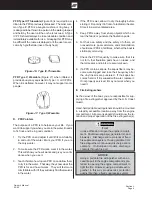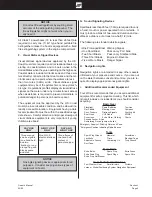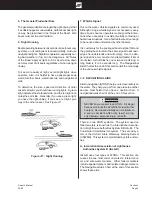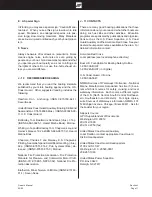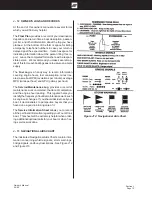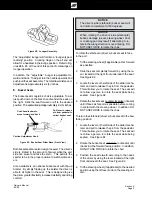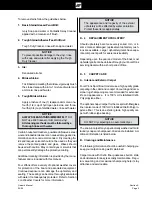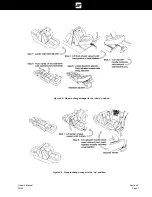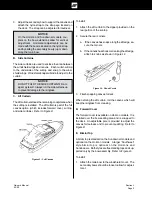
Owner’s Manual
05/00
Section J
Page 9
7. Whistle Signal
Out on the water, whistle signals are commonly used.
Although using a whistle signal is not necessary every
time a boat is nearby, operators must signal their inten-
tions when necessary to avoid potentially confusing or
hazardous situations. Use whistle blasts early enough
to be noticed and understood by other boaters.
It is customary for the privileged boat to signal first and
the yielding boat to return the same signal to acknowl-
edge she understands and will comply. Use the dan-
ger signal (five or more short and rapid blasts) if intent
is not clear. A short blast is one or two seconds long. A
long blast is 4 to 6 seconds long. The Navigational
Aids Chart at the end of this section lists the meanings
of the various whistle signals.
J - 9 NAVIGATIONAL AIDS
Aids to navigation (ATONS) help you to travel safely on
the water. They help you get from one place to another
and are most helpful if you have a nautical chart. A
navigational aids chart is at the end of this section.
NEVER tie your vessel to an ATON. It is illegal
because it blocks the ATON from view of other
boaters. Decreased visibility can contribute to
a serious accident which may result in prop-
erty damage, personal injury, or death.
There are two ATON systems. The system used on
federal waters is known as the International Associa-
tion of Lighthouse Authorities System B (IALA-B). The
Coast Guard maintains this system. The second sys-
tem is the Uniform State Waterway Marking System
(USWMS). This system is maintained by state authori-
ties.
A. International Association of Lighthouse
Authorities System B (IALA-B)
IALA-B uses four types of ATONS. This section dis-
cusses the two most common markers: lateral mark-
ers and safe water markers. Other federal markers
include special markers and isolated danger markers.
The Navigational Aids Chart at the end of this section
shows these aids.
5. The General Prudential Rule
The general prudential rule regarding right-of-way is that
if a collision appears unavoidable, neither boat has right-
of-way. As prescribed in the “Rules of the Road”, both
boats must act to avoid collision.
6. Night Running
Boats operating between sunset and sunrise (hours vary
by state), or in conditions of reduced visibility, must use
navigational lights. Nighttime operation, especially dur-
ing bad weather or fog, can be dangerous. All “Rules
of the Road” apply at night, but it is best to slow down
and stay clear of all boats regardless of who has right-
of-way.
To see more easily at night, avoid bright lights when
possible. Also, it is helpful to have a passenger keep
watch for other boats, water hazards, and navigational
aids.
To determine the size, speed and direction of other
vessels at night, you should use running lights. A green
light indicates the starboard side, and the red light indi-
cates the port side. Generally, if you see a green light,
you have the right-of-way; if you see a red light, give
way to the other vessel. See Figure J11.
Figure J11: Night Running
Содержание Horizon 200
Страница 1: ......
Страница 56: ...Owner s Manual 05 00 Section G Page 6 Figure G7 General Water System Diagram WATER SYSTEM ...
Страница 80: ...Owner s Manual 05 00 Section J Page 15 Figure J16 Skiing Signals ...
Страница 131: ...Owner s Manual 05 00 Fuel Log Page 1 FUEL LOG DATE HOURS RUN FUEL GAL RANGE MILES RPM MPH GPH ...
Страница 132: ...Owner s Manual 05 00 Fuel Log Page 2 FUEL LOG DATE HOURS RUN FUEL GAL RANGE MILES RPM MPH GPH ...
Страница 133: ...Owner s Manual 05 00 Fuel Log Page 3 FUEL LOG DATE HOURS RUN FUEL GAL RANGE MILES RPM MPH GPH ...
Страница 134: ...Owner s Manual 05 00 Service Log Page 1 SERVICE LOG DATE HOURS MAINTENANCE PERFORMED ...
Страница 135: ...Owner s Manual 05 00 Service Log Page 2 SERVICE LOG DATE HOURS MAINTENANCE PERFORMED ...
Страница 136: ...Owner s Manual 05 00 Service Log Page 3 SERVICE LOG DATE HOURS MAINTENANCE PERFORMED ...
Страница 138: ...Page 1 1998 1999 MODEL YEAR 200 HORIZON 245 SUNDOWNER Electrical Schematics ...
Страница 140: ......










